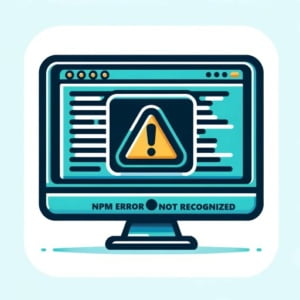[SOLVED] ‘NPM Is Not Recognized’ Error Solutions

If you encounter the issue of “npm is not recognized” on your system, it can be frustrating and halt your development process. At IOFLOOD, we’ve faced this challenge enough times to warrant the creation of this guide. By following our steps and tips, you’ll be able to troubleshoot and fix the problem, ensuring that npm is recognized and accessible on your system.
This guide will help you unlock the door to npm’s functionality, ensuring that you can continue your development work without interruption. By following our step-by-step instructions, you’ll not only resolve this issue but also gain a deeper understanding of how npm integrates with your system.
Let’s overcome this obstacle together and get back to smooth development workflows!
TL;DR: What Do I Do If ‘npm is not recognized’ on My System?
This error typically occurs when npm’s installation path is not included in your system’s environment variables. To quickly fix it, add npm’s path to your system’s PATH environment variable with a command such as
setx PATH "%PATH%;C:\path\to\node;C:\path\to\npm". Replace “C:\path\to\node” and “C:\path\to\npm” with the actual paths where Node.js and npm are installed on your system.
Here’s a quick example for Windows:
setx PATH "%PATH%;C:\Program Files\nodejs;C:\Users\YourUserName\AppData\Roaming\npm"
This command adds the default installation path of npm to your system’s PATH environment variable, ensuring that your system can recognize npm commands. Remember, this change will take effect from the next Command Prompt session you start.
Dive deeper into this guide to learn how to locate your npm installation and properly set your PATH variable on different operating systems, ensuring seamless development experience.
Table of Contents
Locating NPM Installation on Windows
For beginners encountering the ‘npm is not recognized’ error, the root cause often lies in npm’s installation path not being included in the system’s PATH environment variable. Understanding and fixing this issue is crucial for running npm commands seamlessly.
What is the PATH Environment Variable?
The PATH environment variable is a critical system setting that lists directories where executable files are located. When you run a command like npm, your system searches these directories to find the npm executable. If it doesn’t find npm in any of these directories, it returns the ‘npm is not recognized’ error.
Step-by-Step: Add NPM to PATH
- Find NPM’s Installation Path:
First, you need to locate where npm is installed. Open a Command Prompt and type:
where npm
# Output:
# C:\Program Files\nodejs\npm
This command searches for the npm executable within your system and returns its location. The output shows the directory where npm is installed.
- Add NPM to System PATH:
With the npm installation path identified, you can now add it to your system’s PATH. Right-click on ‘This PC’ or ‘My Computer’ on your desktop, select ‘Properties’, then ‘Advanced system settings’. In the ‘System Properties’ window, click on ‘Environment Variables’. In the ‘System variables’ section, find the ‘Path’ variable and select ‘Edit’. In the ‘Edit environment variable’ window, click ‘New’ and paste the npm installation path you found earlier. Click ‘OK’ to save your changes.Remember, changes to environment variables only take effect in new Command Prompt sessions. Restart your Command Prompt to see the changes.
By following these steps, you’ve not only resolved the ‘npm is not recognized’ error but also gained a fundamental understanding of how the PATH environment variable works and why it’s essential for running npm commands and other executable files.
Setting PATH on macOS and Linux
Once you’ve tackled the basic understanding of the PATH environment variable on Windows, it’s time to broaden your skills to macOS and Linux systems. The process differs slightly but follows the same principle: ensuring your system knows where to find npm.
macOS PATH Configuration
On macOS, the Terminal app is your gateway to modifying the PATH variable. Here’s how you can add npm to your PATH:
- Open Terminal: Use Spotlight search (
Cmd + Space) and type ‘Terminal’. Edit
.bash_profileor.zshrc: Depending on your shell (Bash or Zsh), you’ll edit one of these files in your home directory. For Bash users, it’s.bash_profile; for Zsh users, it’s.zshrc.
echo 'export PATH="/usr/local/bin/npm:$PATH"' >> ~/.bash_profile
# For Zsh users, replace '.bash_profile' with '.zshrc'
source ~/.bash_profile
# For Zsh, source ~/.zshrc
# Output:
# No output expected, but this command refreshes your profile, applying the changes.
This command appends the npm directory to your PATH variable in the profile file and then refreshes your profile to apply the changes. No output is expected, but this ensures your system can now recognize npm commands.
Linux PATH Configuration
The process for Linux is similar to macOS, with minor differences in file paths and user interfaces.
- Open a Terminal: You can find it in your applications menu or use a keyboard shortcut.
Identify Your Shell: Most modern Linux distributions use Bash, but it’s good to check. Type
echo $SHELLin your terminal.Edit
.bashrcor Your Shell’s Profile: Use a text editor to add the npm path to your.bashrcfile for Bash users, or the equivalent for your shell.
echo 'export PATH="/usr/local/bin/npm:$PATH"' >> ~/.bashrc
source ~/.bashrc
# Output:
# No output expected, but this refreshes your bash profile, applying the changes.
Similar to macOS, this command adds the npm directory to your PATH variable and refreshes your profile.
Troubleshooting Common Pitfalls
Both macOS and Linux users might encounter issues if the npm directory is not correctly identified or if permissions prevent modifying profile files. Ensure you have the correct path to npm by using which npm to locate it. If you encounter permission issues, prefixing commands with sudo may be necessary, but use this with caution and understand the implications.
Terminal Profiles for PATH Changes
Understanding and utilizing terminal profiles (~/.bash_profile, ~/.zshrc, or ~/.bashrc) is crucial for making persistent changes to your PATH. These files are executed each time a terminal session starts, ensuring that your PATH settings are consistently applied across sessions.
By mastering these steps, you’re well on your way to overcoming the ‘npm is not recognized’ error across different operating systems, broadening your development capabilities.
Exploring Alternative Solutions
When the usual fixes don’t resolve the ‘npm is not recognized’ error, it’s time to consider alternative approaches. These methods cater to those with a deeper understanding of their development environment and are looking for robust solutions.
Reinstall Node.js and NPM
A fresh installation can sometimes be the quickest way to solve the issue. Uninstalling and then reinstalling Node.js (which includes npm) ensures that any corrupted files or misconfigurations are wiped clean.
# Uninstall Node.js and npm
# Installation commands vary based on the operating system
# For example, on Ubuntu, you might use:
sudo apt-get remove nodejs npm
# Reinstall Node.js and npm
# Again, this depends on your OS
# For Ubuntu, the command might be:
sudo apt-get install nodejs npm
# Output:
# 'nodejs' and 'npm' packages will be removed and then reinstalled
This process removes the existing Node.js and npm installations and reinstalls them. It’s a straightforward way to ensure that the installation paths and configurations are set to their defaults.
Using a Version Manager
For developers juggling multiple projects, using a Node version manager like nvm can provide flexibility and prevent path issues.
# Install nvm
# Visit https://github.com/nvm-sh/nvm for the latest installation script
# Use nvm to install Node.js and npm
nvm install node
# Output:
# 'Downloading and installing node vXX.XX.X...'
# 'Installing npm...'
# 'Now using node vXX.XX.X (npm vX.XX.X)'
Using nvm allows you to install multiple versions of Node.js and npm, easily switch between them, and more importantly, manage their paths more effectively. This approach can mitigate the ‘npm is not recognized’ error by ensuring that npm’s path is correctly set according to the version in use.
Resetting Environment Variables
In some cases, environment variables can become cluttered or incorrectly set. Resetting these to their default settings can sometimes clear up path issues.
# Example of resetting PATH variable to default on Windows
# Note: This will remove all custom paths. Use with caution.
setx PATH "C:\Windows\system32;C:\Windows"
# Output:
# 'SUCCESS: Specified value was saved.'
Resetting the PATH variable to its default setting removes any custom paths that might be causing conflicts. This step should be taken with caution, as it will remove all custom paths, potentially affecting other applications.
By considering these alternative approaches, developers can find a solution that best fits their situation. Whether it’s a clean reinstall, leveraging a version manager, or resetting environment variables, each method has its pros and cons. Understanding these options allows for a more informed decision-making process in resolving the ‘npm is not recognized’ error.
Troubleshooting and Common Issues
When you encounter the ‘npm is not recognized’ error, it’s crucial to approach troubleshooting systematically. This error can stem from a variety of issues beyond just a missing PATH variable. Let’s delve into common causes and their solutions.
Incomplete Installations
An incomplete or corrupted Node.js and npm installation is a frequent culprit. Ensure that both Node.js and npm are correctly installed by running:
node -v
npm -v
# Output:
# 'v14.17.0' (or your version of Node)
# '6.14.13' (or your version of npm)
This command checks the versions of Node.js and npm installed on your system, confirming their presence. If you receive an error for either command, it suggests an issue with the installation process that needs addressing.
User Permissions
Permission issues can prevent npm from being recognized, especially on macOS and Linux. Running npm commands with sudo can temporarily bypass these issues, but it’s not a recommended practice due to security concerns. Instead, consider adjusting the ownership of your npm directories:
sudo chown -R $(whoami) ~/.npm
# Output:
# No explicit output, but this command changes the ownership of the npm directory to the current user.
This command reassigns the ownership of the npm directory to the current user, potentially resolving permission-related errors. Remember, using sudo for npm commands is generally discouraged unless absolutely necessary.
Software Conflicts
Conflicts with other software, especially other versions of Node.js or npm installed via different methods (e.g., directly downloading the installer vs. using a version manager like nvm), can cause the ‘npm is not recognized’ error. Ensure that only one version of Node.js and npm is installed and that it’s the one referenced in your PATH.
Future-Proofing Your Setup
To avoid these issues in the future, consider:
- Regularly updating Node.js and npm to their latest versions.
- Using a Node version manager like nvm to manage multiple Node.js versions without path conflicts.
- Periodically verifying your PATH variable and environment settings to ensure they correctly reference your Node.js and npm installation paths.
By understanding these common pitfalls and how to address them, you can minimize the chances of encountering the ‘npm is not recognized’ error and maintain a smooth development environment.
The Usages and Role of NPM
NPM, or Node Package Manager, is the backbone of modern web development. It’s a command-line utility that facilitates package management for Node.js applications, allowing developers to install, update, and manage dependencies with ease.
NPM’s Role in Development
NPM streamlines the process of working with Node.js projects by managing the various packages your project depends on. It automates the process of installing, updating, and removing packages, making it easier to manage your project’s dependencies.
Installation with Node.js
NPM is installed automatically alongside Node.js. Here’s a quick way to verify your Node.js and npm installations:
node --version
npm --version
# Output:
# 'vXX.XX.X' (Your Node.js version)
# 'X.XX.X' (Your npm version)
This command outputs the versions of Node.js and npm installed on your system, confirming their presence. It’s essential to ensure that both are correctly installed for npm to be recognized by your system.
The Role of Environment Variables
Environment variables play a crucial role in the functionality of operating systems. They are used to define the execution environment for applications, including paths to executable files. The PATH environment variable is particularly important for developers, as it tells the operating system where to find the executables for command-line utilities like npm.
echo $PATH
# Output:
# /usr/local/bin:/usr/bin:/bin:/usr/sbin:/sbin
This command displays the current PATH setting on a Unix-like system, showing the directories that the system searches for executables. If npm’s installation directory is not listed here, the system won’t recognize npm commands.
Understanding the fundamentals of npm and the importance of environment variables is crucial for any developer. This knowledge not only helps in troubleshooting ‘npm is not recognized’ errors but also in setting up a development environment that’s efficient and error-free.
NPM in Modern Web Development
NPM is not just a tool for installing and managing packages; it’s a fundamental part of the modern web development ecosystem. Its versatility extends to managing dependencies for large projects, streamlining the development process, and facilitating continuous integration/continuous deployment (CI/CD) pipelines.
Leveraging NPM in Large Projects
In larger projects, npm helps manage not just the direct dependencies but also the vast network of sub-dependencies, ensuring that the entire project’s dependency tree is consistent and up-to-date. This management is crucial for maintaining project stability and security.
NPM and CI/CD Pipelines
NPM integrates seamlessly with CI/CD pipelines, automating the process of package installation and build processes. This automation ensures that your application is always built with the correct dependencies, leading to more reliable deployment processes.
# Example of using npm in a CI/CD pipeline
npm install && npm run build
# Output:
# Installs dependencies and then builds the project
# 'Project built successfully'
This code block demonstrates how npm commands can be incorporated into CI/CD scripts to automate the installation of dependencies and the building of the project. The output confirms the successful execution of these tasks, illustrating npm’s role in simplifying and automating development workflows.
Further Resources for NPM Mastery
To deepen your understanding of npm and leverage its full potential in your web development projects, consider exploring the following resources:
- NPM Documentation: The official npm documentation provides comprehensive guides on npm commands, package.json configurations, and npm scripts.
Node.js Guides: These guides cover various aspects of Node.js, including how to use npm and create npm packages.
The npm Blog: For the latest news, updates, and tips on using npm effectively in your projects.
These resources offer valuable insights and practical tips for mastering npm, enhancing your development workflow, and contributing to the success of your projects.
Recap: ‘NPM Is Not Recognized’ Error
In this comprehensive guide, we’ve tackled the pesky ‘npm is not recognized’ error, a common hurdle for developers. This error can be a significant roadblock, but with the right knowledge, it’s one you can easily overcome.
We began with the basics, understanding why this error occurs—typically a missing link in the PATH environment variable. We then walked through how to locate your npm installation and ensure it’s included in your system’s PATH, a crucial step for Windows users.
For macOS and Linux users, we delved deeper into setting the PATH variable and highlighted the importance of terminal profiles for persistent PATH changes. We also explored troubleshooting common pitfalls, such as permission issues or conflicts with other software, which can lead to this error.
In addition to these methods, we examined alternative approaches for more experienced users. This included reinstalling Node.js and npm, using a version manager like nvm, and resetting environment variables to their default settings.
| Approach | Pros | Cons |
|---|---|---|
| Setting PATH | Direct, solves most issues | Can be complex for beginners |
| Reinstalling Node.js/npm | Cleans slate, often fixes | Time-consuming |
| Using nvm | Manages versions easily | Learning curve |
Whether you’re just starting out with npm or you’re an experienced developer looking for a refresher, we hope this guide has equipped you with the tools to fix the ‘npm is not recognized’ error.
The journey doesn’t stop here. NPM is a powerful tool in web development, and mastering it opens up a world of possibilities. From managing project dependencies to automating builds and deployments, npm is integral to modern development workflows. We encourage you to explore npm further through additional resources, enhancing your development skills and contributing to your projects’ success. Happy coding!

